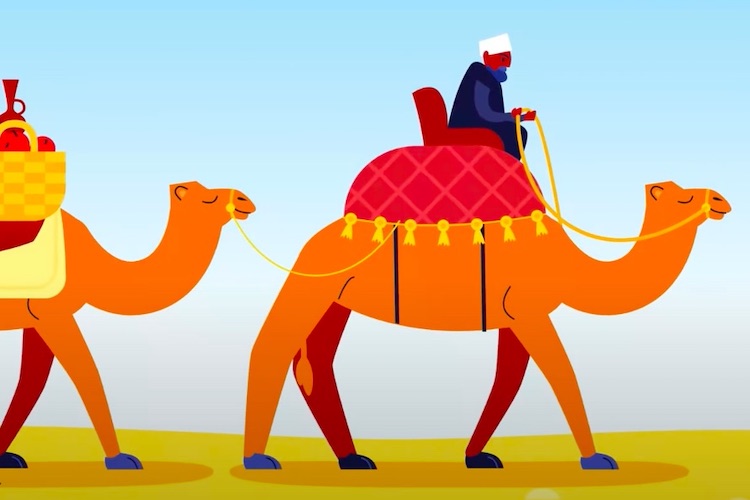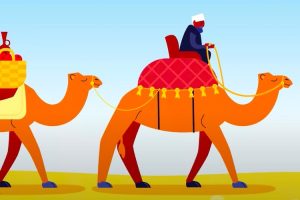Arts and Humanities in Higher Education
David Dussault on human relationships, life experience and how to understand the influence that IT has on our ...

The Silk Road is a broad term that refers to the routes taken by travelers and overland trade through Central Asia. Its location varied over time. When the geographer Ferdinand von Richthofen coined the term in 1877, he was thinking of the routes linking Rome to China. Nowadays, however, the term refers to any trans-Eurasia route that links China with points to the West.
In the earliest period of known activity (overland routes were certainly in use before this), circa 1200 BCE, jade traveled from the oasis of Khotan, in western Xinjiang, to the graves of the Shang kings in Anyang, Henan. In the Han dynasty (206 BCE-220 AD) and the third and fourth centuries, the most important contacts were between China and India. This was the time when Buddhism first entered China.
After the fifth century, a period of great chaos, the Silk Road linked China with the Iranian world, particularly Samarkand, which was the heartland of Sogdiana. During the first half of the Tang dynasty (618-907), or before 755, the Chinese army stationed troops in modern Xinjiang, and they bought many goods, contributing to the prosperity of the region. At this time the route linked the Tang capital of Chang’an with Samarkand; the northern route went north around the Taklamakan and the southern route – south around the desert.
The grasslands route, which was several hundred km to the north, connected the Mongol capital at Karakorum with points to the west, through Siberia to the Black and Caspian Seas. It was in use in the 1200s and 1300s. The maritime Silk Road, which connected China with Southeast Asia, India, and the Islamic world, was in use starting in the year 400 CE and continuing until 1500 when the world’s sea routes shifted to focus on Europe.
When considering where our information about the Silk Road comes from, it makes sense to focus on the period between 200 and 1400, the period of greatest activity on the Silk Road. The sources fall into three groups: transmitted textual sources, excavated documents, and archeological artifacts.
All of Central Asia’s neighbors produced documents about the Silk Road: the most plentiful sources are in Chinese. All of the dynastic histories contain a section describing the oasis kingdoms of the region, which are crucial to reconstructing the local history of these kingdoms. There are also sources in Greek, Latin, Arabic, and Persian, to name the most important of the other languages.
When archeologists steamed these artifacts apart, the hidden layers of paper separated and revealed their written secrets. To scholars’ amazement, they found themselves reading about the cost of cloth, property disputes, medical prescriptions, and the price of a slave girl on a particular market day over one thousand years ago. In addition, the dry climate of the Taklamakan Desert preserves a wide variety of archeological artifacts. These provide tangible information about how local people lived: what they ate, what kind of textiles they wove, and how their houses were built.
Trade on the Silk Road consisted largely of impromptu exchanges of locally produced and locally obtained goods. Many of the goods people bought and sold were locally produced. One market register survives from Turfan, and it lists all the different items for sale at the market in 743 CE: vegetables, animals, and textiles. The one good that came from far away was brass-inlaid, high-quality swords, which were for sale alongside cheaper, locally-made knives.
Silk was not the most important good on the road; paper, invented in China in the second century BCE, had a bigger impact in Europe and the Islamic world, while metals, spices, and glass were just as important as silk. One of the most common goods on the Silk Road was ammonium chloride. Sometimes called “sal ammoniac,” it had multiple uses: as a leather softener, as a flux to lower the temperature of metals, and for dying textiles. Much of it came from modern-day Uzbekistan.
A key actor in the Silk Road economy was the Tang government, which sent out thousands of bolts of silk as pay to its armies. Silk was much lighter than coins, so it made sense to ship silk, not coins, to the northwest – and the government was chronically short of coins anyway. Once paid, the soldiers then spent their money in local markets, which contributed to the prosperity of the region. Government spending, not private trade, sustained the Silk Road. In fact, private trade was sporadic and relatively low in volume, utterly unlike these shipments of silk by the government.
During the Tang dynasty, thriving in their new homes, the migrants to China mixed with the people already there and often assimilated with other groups who followed. While not much of a commercial route, the Silk Road was important historically—this network of routes became the planet’s most famous cultural artery for the exchange of religions, art, languages, and new technologies between East and West.
Waves of immigrants brought technologies with them from their homeland and then practiced those skills in their new homes. The frequent migrations of people fleeing either war or political conflicts in their homelands meant that some technologies moved east, others west. The technologies for manufacturing paper and weaving silk were transported west out of China at the same time that the techniques for making glass entered China.
Rulers also sent envoys to visit the courts of other rulers. Envoys often carried gifts – usually small, light objects – to their hosts, and they returned with valuable information about them, serving as a type of spy. Itinerant artists also moved along these routes, bringing sketchbooks and introducing motifs from their homelands. In addition to the refugees and envoys who made their way along these routes, artists, craftsmen, and robbers also traveled on the Silk Road. Sometimes they resorted to trading to cover their travel expenses, but that was not their primary purpose in traveling.
People also traveled the Silk Road for the purposes of religion: missionaries left China to learn more about Buddhist teachings, and missionaries from the Zoroastrian world, centered on Iran, the Manichean religion, also in Iran, and the Christian Church of the East, based in Syria, all went to the Western regions and to Chang’an. Several important religions existed on the Silk Road before the year 1000 CE: Buddhism was the most important, but devotees of Zoroastrianism and Manicheism, mostly from Iran, and of the Christian Church of the East, based in Syria, also moved along these Central Asian trade routes. Local rulers tended to be Buddhist, but they allowed people of other religions to practice their faiths. Sometimes they even donated funds for non-Buddhist temples and sacrifices.
The coming of Islam marked a sea change. The city of Khotan came under Islamic rule sometime around 1006 CE, and the conquering armies deliberately targeted Buddhist temples and monasteries. It took centuries before Islam became established in Xinjiang, but eventually, between 1000 and 1500, Central Asia — both the “Stans” and Xinjiang — was Islamicized. Almost all local rulers and their subjects converted since any rulers who converted to Islam required their subjects to convert as well.
In every Silk Road site that has produced documents, a large share of the materials concern the law, legal matters, and disputes. These different communities were home to people of different ethnicities who spoke different languages, but they accepted legal mediation by officials even when they had no language in common with them. People sought help in the most minor of disputes – an animal had been stolen, or someone failed to do what he had promised to – and they cited the law to support their position.
We see this constant recourse to the law in war-torn Niya in the 3rd and 4th centuries, where families frequently had to give up their children for adoption. If they made a payment to the adopting family, called a milk payment, their child was supposed to be treated as a family member. If they did not, then the child could be asked to perform the same labor as a slave. Over and over again, birth mothers and fathers bring their complaints to the local king to ask officials to intervene and make sure that the adoptive parents treat their children properly. These documents are in a language related to Sanskrit, and they reflect the Indian legal tradition.
Only about one hundred documents in Sogdian, the language of the most important Silk Road traders, survive. The largest cache of Sogdian-language materials, found at Mt. Mugh in modern-day Tajikistan, includes a detailed marriage contract between a husband and his wife, each of whom kept a copy. The marriage contract spells out the circumstances under which the man – and, unusually for the time, the woman – could ask for a divorce and how the property was to be divided.
This widespread respect for the law along the Silk Road is heartening. It allowed people who spoke different languages and believed in different religions to live together, most of the time harmoniously.
The Silk Road initiative, announced by Chinese President Xi Jinping in 2013 and initiated in 2015, contemplates so vast an investment in highways, ports, and railways that it will transform the ancient Silk Road into a ribbon of gold for surrounding countries. Multiple new trade corridors could potentially run through Xinjiang, Pakistan, Afghanistan, and many other “Stans” to Europe, although the government has still not issued an official map, and no one knows where the roads will actually lead. Officially called “The Silk Road Economic Belt and the 21st Century Maritime Silk Road,” the project also has the shorter title, “One Belt, One Road,” or OBOR for short.
One clue to Beijing’s intentions is a map of the five post-Soviet countries of Kazakhstan, Uzbekistan, Turkmenistan, Kyrgyzstan, and Tajikistan—collectively known as the “Stans”—that appeared in the Chinese press before the Foreign Ministry retracted it. The ministry itself simply claims that the new road is open to any country that accepts Chinese investment in its infrastructure. For instance, Hungary was the first European country to sign a formal MOU with China on 7 June 2015. Poland has been assured that it, too, is welcome, and a railroad already connects Warsaw with the city of Chengdu in Sichuan province.
What we do know is this: any country that participates in these colossal infrastructural undertakings will enjoy unprecedented Chinese investment and, most likely, real economic benefits. China’s official announcements emphasize the positive connotations of the Silk Road; historically, no conquests, no wars, and no imperialism took place on the Silk Road—at least as most people imagine to be the case. Chinese officials also speak in glowing terms about the initiative as “happy,” “lovely,” and above all else, “win-win.”
There is good reason to be suspicious. If China is investing money—currently, the amounts are estimated to be over forty billion in Pakistan alone—more is involved than simply a “happy,” “lovely” scenario.
Edited by Alina Shubina

David Dussault on human relationships, life experience and how to understand the influence that IT has on our ...

Shlomo Izre'el on the myths about the Hebrew language, its relations with Yiddish, and how children teach thei...

Historian Valerie Hansen on cultural exchange, the history of the Silk Road, and the historical documents that...